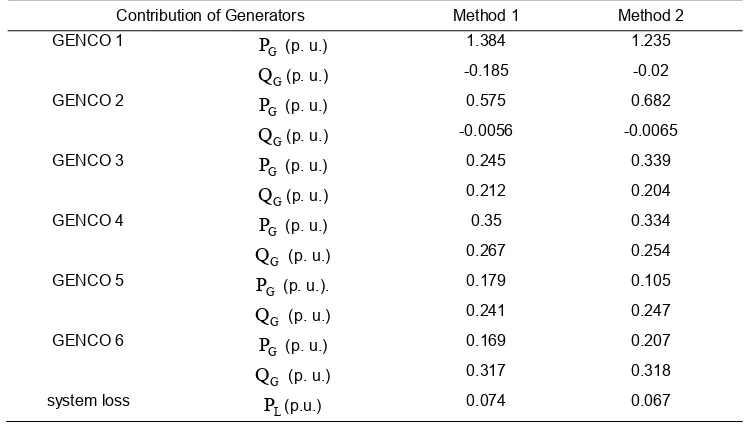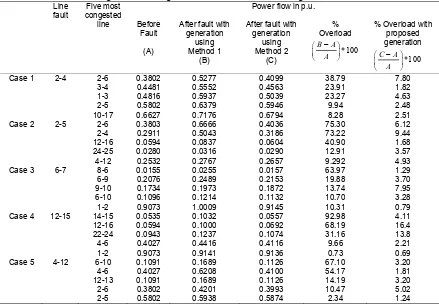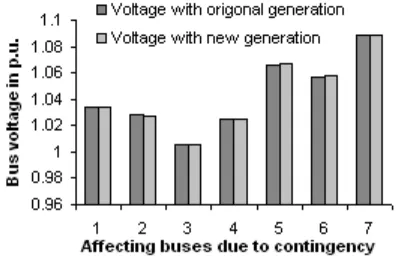accredited by DGHE (DIKTI), Decree No: 51/Dikti/Kep/2010 1
Generator Contribution Based Congestion Management
using Multiobjective Genetic Algorithm
Sawan Sen*1, Priyanka Roy2, Abhijit Chakrabarti3, Samarjit Sengupta4 1,2EE Department, Techno India, Kolkata, India
3EE Department, Bengal Engineering and Science University, Shibpur, India 4Department of Applied Physics, Kolkata, West Bengal, India
e-mail: [email protected]*1, [email protected], [email protected], [email protected]
Abstrak
Manajemen kongesti adalah salah satu fungsi utama operator sistem pada industri daya terstrukturisasi selama kontigensi tak terduga. Makalah ini mengusulkan sebuah metoda manajemen kongesti menggunakan algorithma genetik muti-objek berbasis kontribusi pembangkit. Pada algoritma ini, rugi-rugi real dan reaktif dioptimasi menggunakan model aliran daya optimal dan kontribusi dari pembangkit yang rugi-ruginya dioptimalkan adalah dikalkulasi. Pada level kedua, jalur yang mengalami kongesti diidentifikasi dengan indeks beban berlebih yang diusulkan selama kontigensi, dan jalur tersebut dilonggarkan dengan kontribusi baru dari pembangkit, yang merupakan keluaran dari algoritma yang dikembangkan. Metoda yang direncanakan menggambarkan informasi terkait manajemen kongesti untuk meminimalkan biaya investasi, tanpa instalasi piranti eksternal dan untuk memaksimalkan kesejahteraan konsumen dengan menghindari pembatasan beban tanpa mengakibatkan profil tegangan dari sistem sedemikian hingga rugi sistem total teroptimasi. Sistem bus IEEE 30 digunakan untuk mendemonstrasikan keefektifan dari metode yang diusulkan.
Kata kunci: algoritma genetik, indeks beban berlebih, jaringan daya teregulasi, kontigensi, manajemen kongesti
Abstract
Congestion management is one of the key functions of system operator in the restructured power industry during unexpected contingency. This paper proposes a method for generator contribution based congestion management using multiobjective genetic algorithm. In the algorithm, both real and reactive losses have been optimised using optimal power flow model and the contributions of the generators with those optimised losses are calculated. On second level, the congested lines are identified by the proposed overloading index (OI) during contingency and those lines are relieved with the new contribution of generators, which is the outcome of the developed algorithm. The planned method depicts the information related to congestion management to minimize the investment cost, without installing any external devices and to maximise the consumer welfare by avoiding any load curtailment without affecting the voltage profile of the system as well as the optimised total system loss. IEEE 30 bus system is used to demonstrate the effectiveness of the method.
Keywords: congestion management, contingency, deregulated power network, genetic algorithm, overloading index
1. Introduction
TELKOMNIKA Vol. 9, No. 1, April 2011 : 1 – 8
loss allocation. In other literature [9] genetic algorithm (GA) technique is also used for loss tracing. Although loss allocation can be ensured but still no bodies can guarantee that unexpected situations such as generator fault, line fault or tripping would not happen. In this unprecedented state, the loss allocation may change and some new technique has to be implemented to maintain system security.
For the development of the proposed technique, contingency like tripping of line has to be considered. In case of any kind of line fault of the power network, the power, which had flowed through the tripped line, should flow through other existing lines to meet consumer’s expectation [10]. This causes the possibility of other line becomes overloaded or congested. Thus transmission loss during power transmission and line congestion are the most important issues for deregulated power environment, where spot price is the main consideration for consumer welfare. Hence, a transparent method for congestion relief during contingency and allocating transmission loss between all of the interested parties in an equitable and fair manner is required. There are several researches in exploiting the releasee of line overflow. Congestion of line can be managed by different way e.g. load curtailment, economic load management, VAR support [11].
At this step, an essential and challenging task is to develop a soft computing method, which optimize the total system loss as well as generate power schedule to minimize the investment cost with out installing any external devices and to maximise the consumer welfare by avoiding any load curtailment for congestion management under deregulated environment.
In this paper, the basic concept of GA based loss optimization is laid under the OPF model where loss is function of B-coefficients for active power and C-coefficient for reactive power. With the optimised loss values, the generator contribution also has been found out through this proposed model. In the paper, an overloading index (OI) has also been proposed to find out the congested lines for any type of contingency. The generation schedule, with optimized loss also has been used to relief line overflow without load curtailment even during contingency. Through classical analysis, voltage profile has been checked with proposed generation schedule, which yields satisfactory result. Actually GA analysis helps to find out the most effective generation schedule, which has been used for congestion management along with loss optimisation of the overall system. It also assists to come to a decision that no external compensation, load curtailment is required for congestion management up to a certain limit in a deregulated power environment.
2. Proposed Method
In this paper, the flow of proposed method is devided in two steps. In the first step, generator contribution can be determined based on loss optimization using GA and these re-contributions of generators have been used to relief the congested transmission lines during contingency in the next step.
2.1. Loss Optimization using GA
GA is a global adaptive search technique based on the mechanics of natural genetics [9]. It is applied to optimize existing solutions by using biological evolution based methods.It has many applications in certain types of problems that yield better results than the commonly used methods without any complicated classical calculation. To solve a specific problem with GA, a function known, as objective function needs to be constructed which allows different possible solutions to be evaluated. The algorithm will then take those solutions, which seem to show some activity towards a working solution.
2.1.1. Problem formulation considering OPF
The objective function for conventional cost optimization is as follows
But in the proposed method, the objective function considering the total active and reactive loss can be formulated as follows
( )
PL and QL, the active and reactive loss terms can be expressed using B and C-coefficient [12] as follows:
The inequality or generator output constraints
min 0 max
2.1.2. Problem Encoding
TELKOMNIKA Vol. 9, No. 1, April 2011 : 1 – 8 2.1.3. Initialization
Usually, at the beginning of the GA optimization process, each variable gets a random value from its predefined domain. The generator power outputs have well-defined lower and upper limits, and the initialization procedure commences with these limits given by
min max
2.1.4. Constraint functions and parent selection
Implementation of a problem in a genetic algorithm is realized within the constraint function. The proposed approach uses the conventional power balance equation as its constraint which can be written as
1 tolerance. Improvement of the average fitness of the population is achieved through selection of individuals as parents from the completed population. The selection is performed in such a way, that chromosomes having higher fitness are more likely to be selected as parents.
2.1.5. Crossover and Mutation
After the selection, GA applies a random generation to cut the strings at any position (the crossover point) and exchanges the substrings between the two chromosomes. Once the crossover is performed, the new chromosomes are added to the new population set. Mutation being another parameter, it involves randomly selecting genes within the chromosomes and assigning them random values within the corresponding predefined interval. The probability of mutation is normally kept very low, as high mutation rates could degrade the evolving process into a random search process.
2.2. Congestion Management with Re- Contribution of Generators
With the re-contribution of generators using equation (3) and (4), congested lines can be relieved during contingency. To find the contingent lines during contingency, an Overloading Index can be defined as change in power flow through a transmission line during contingency of other lines. Mathematically it can be expressed as follows
mn mn
where, Pmn and Pmn are the active power flow through the line m-n after contingency and before contingency respectively. Higher value of this index indicates the more congested line in the power network.
3. Results and Discussion
The feasibility and effectiveness of the proposed method has been demonstrated in the IEEE 30 bus test system as sketched in Figure 1. The test system and production units’ properties are given in Tables 1 and 2. For the entire simulation, logic program in GA has been employed to formulate ac power flow model. The standard parameters settings for all the simulations of the adopted GA have been depicted in Table 3.
proposed multiobjective optimization method maintaining the real and reactive loss ((3) and (4)) for a fixed active demand of 283.6 MW and reactive demand of 126.2 MVAR.
Figure 1. Single line diagram (SLD) of IEEE 30 bus test system
Table 1. Test system properties
Name of parameters Value
Number of buses 30
Number of generator units 6
Number of branches 43
Number of tie lines 6
Total power demand in MW 283.6
Table 2. Production units’ properties
Generator
Table 3. Parameter setting of GA based optimization
Name of the parameters Value
Population size 20
Selection stochastic uniform
Mutation adaptive feasible
Crossover scattered
Table 4. Comparison of generators contributions obtained from conventional cost optimization method (method 1) and proposed multiobjective optimization method (method 2)
Contribution of Generators Method 1 Method 2
GENCO 1
TELKOMNIKA Vol. 9, No. 1, April 2011 : 1 – 8
Figure 2. Change in Real and Peactive Power in p.u. for Multiobjective optimization method
The severity of the line fault depends on the amount of power, which had flowed through the tripped line. In this test, five different lines have been tripped that were chosen according to the amount of line flow considered. Table 5 shows the simulation results. For a particular line fault, five most congested lines have been found with the help of the proposed overloading index. With the calculated contribution of GENCOs (Table 4) using proposed optimization; congested lines can be relieved from overloading (Table 5). A remarkable reduction in line congestion has been observed with proposed generation as compared with the generation obtained from conventional cost optimization technique. This reduction of overloading may reduce the cost of congestion which is an integral part of locational marginal price (LMP) [13] in deregulated environment of power system.
Table 5. Congestion management with new schedule of generators contribution
Line
(method 1) and re-contribution of GENCOs (method 2) during contingencies. As shown, the system operating losses have decreased by a considerable amount with re-contribution schedule of GENCOs. Hence, it can be stated that along with the reduction of congetion cost this proposed method can lower system operating looses and thereby the spot price of energy in deregulated environment.
The above advantages of this re-contribution schedule remains less consequent unless it has least effect on the operating conditions of the system. The voltage profiles shown in the Figures 3 to 5 for the test cases, strengthens the competency of the re-contribution schedule with respect to the normal generation schedule. During contingency the voltage profile remains least affected with the imposed schedule. It implies that without affecting the voltage, this new schedule can offer significant benefits like minimization of system losses and locational marginal prices (LMP) in terms of congestion management during contingency and in normal condition of the system. The other important advantage of calculated re-contribution schedule that has been prepared by GA by optimizing the active and reactive losses in deregulated electricity market is that it does not threaten the economic dispatch.
Table 6. Comparison of real losses with original contribution and re-contribution schedule of GENCOs during contingency
Cases PL in p.u. with % reduction in active loss with
Re-contribution of GENCOs Original contribution of
GENCOs
Re-contribution of GENCOs
Case 1 0.0798 0.0733 8.14
Case 2 0.1427 0.1236 13.38
Case 3 0.0891 0.0775 13.01
Case 4 0.0809 0.0742 8.28
Case 5 0.0813 0.0719 11.48
Figure 3. Comparison of voltage during contingency with original and new generation for Case 1 and 2
TELKOMNIKA Vol. 9, No. 1, April 2011 : 1 – 8
Figure 5. Comparison of voltage during contingency with original and new generation for Case 5
4. Conclusion
This paper proposes a new method, which not only optimizes real and reactive power loss using GA, but also reduces congestion of transmission lines during contingency by using new schedule of generators contributions. The overloading index, proposed in this paper can efficiently trace the congested lines in contingency so that a remedial action can be taken to relief the line from congestion. In this paper, the new generation schedule obtained by the proposed loss optimisation GA model has been taken as a corrective measure for congestion management. This loss optimisation based generation schedule has been coupled with load flow to check the voltage profile of the system along with congestion management of the transmission lines during contingency. The test results show that the new schedule of generation is a powerful tool for congestion management scheme over the other schemes such as load curtailment and FACTS device inclusion.
References
[1] Kyung M, Sang-Hyeon H, Su-Won L, Young-Hyun M. Transmission loss allocation algorithm using path-integral based on transaction strategy. IEEE Transaction on Power Systems. 2010; 25(1):195-205.
[2] Schweppe F, Caramanis R, Tarbor R, Bohn R. Spot pricing of Electricity. Kluwer Academic Publisher. 1988.
[3] Gross G, Tao S. A physical-flow-based approach to allocating transmission losses in a transaction framework. IEEE Transaction on Power Systems. 2000; 15(2): 631–637.
[4] Chang Y-C, Lu C-N. An electricity tracing method with applicationto power loss allocation.
International Journal of Electrical Power Energy Systems. 2001; 23(1): 13-17.
[5] Abdelkar S. Efficient computaton algorithm for calculating load contributions to line flows and losses. IEE proc. Of Generation, Transmission and Distribution. 2006; 153(4): 391-398.
[6] Abedlkar S. Transmission loss allocation in a deregulated electrical energy market. Electrical Power System and Research. 2006; 76(11): 962-967.
[7] Nepomuceno L, Santos Jr. A. Equivalent optimization model for loss minimization: A suitable analysis approach. IEEE Transaction on Power Systems. 1997; 12(4):1403-1412.
[8] Jen-Hao T. Power flow and loss allocation for deregulated transmission system. International Journal of Eletrical Power and Energy System. 2005; 27 (1): 327-333.
[9] Mohd Herwan S, Mohd Wazir M, Omar A. Transmission loss and load flow allocations via Genetic Algorithm technique. IEEE Tencon 2009.
[10] Parnandi S, Schoder K, Feliachi A. Power Market Analysis tool for Congestion management.
International Conference on Electrical Engineering Design and Technologies. 2007: 4-6.
[11] Hwa-S, Seung M. A New Operation Strategy of Series Compensating Device under line flow congestion using linearized line flow sensitivity. Power Engineering Soceity Winter Meeting IEEE 2001; 2: 416-420.
[12] Chakrabarti A, Halder S. Power System Analysis, Operation and Control. Fourth Edition PHI Learning Pvt. Ltd, India. 2010.



